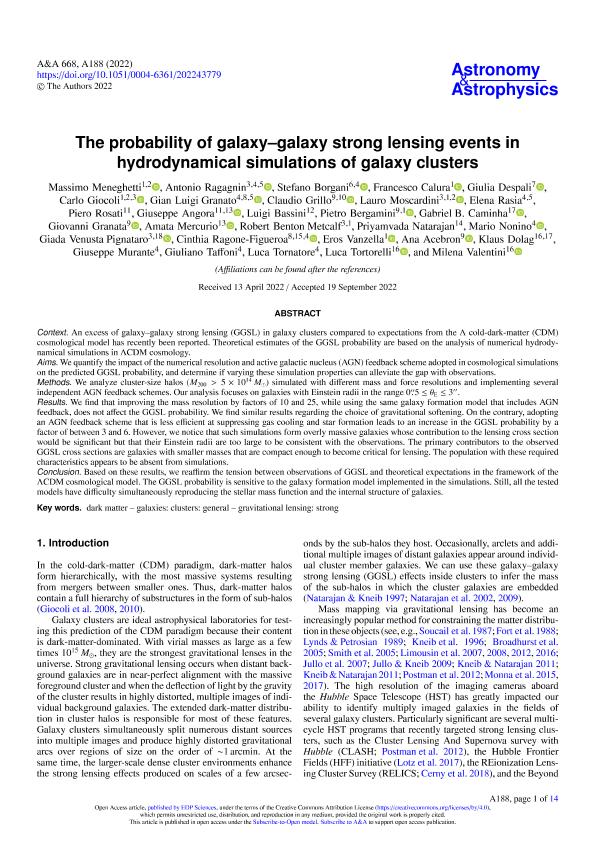Artículo
The probability of galaxy- galaxy strong lensing events in hydrodynamical simulations of galaxy clusters
Meneghetti, Massimo; Ragagnin, Antonio; Borgani, Stefano; Calura, Francesco; Despali, Giulia; Giocoli, Carlo; Granato, Gian Luigi; Grillo, Claudio; Moscardini, Lauro; Rasia, Elena; Rosati, Piero; Angora, Giuseppe; Bassini, Luigi; Bergamini, Pietro; Caminha, Gabriel B.; Granata, Giovanni; Mercurio, Amata; Metcalf, Robert Benton; Natarajan, Priyamvada; Nonino, Mario; Pignataro, Giada Venusta; Ragone Figueroa, Cinthia Judith ; Vanzella, Eros; Acebron, Ana; Dolag, Klaus; Murante, Giuseppe; Taffoni, Giuliano; Tornatore, Luca; Tortorelli, Luca; Valentini, Milena
; Vanzella, Eros; Acebron, Ana; Dolag, Klaus; Murante, Giuseppe; Taffoni, Giuliano; Tornatore, Luca; Tortorelli, Luca; Valentini, Milena
 ; Vanzella, Eros; Acebron, Ana; Dolag, Klaus; Murante, Giuseppe; Taffoni, Giuliano; Tornatore, Luca; Tortorelli, Luca; Valentini, Milena
; Vanzella, Eros; Acebron, Ana; Dolag, Klaus; Murante, Giuseppe; Taffoni, Giuliano; Tornatore, Luca; Tortorelli, Luca; Valentini, Milena
Fecha de publicación:
12/2022
Editorial:
EDP Sciences
Revista:
Astronomy and Astrophysics
ISSN:
0004-6361
Idioma:
Inglés
Tipo de recurso:
Artículo publicado
Clasificación temática:
Resumen
Context. An excess of galaxy galaxy strong lensing (GGSL) in galaxy clusters compared to expectations from the cold-dark-matter (CDM) cosmological model has recently been reported. Theoretical estimates of the GGSL probability are based on the analysis of numerical hydrodynamical simulations in CDM cosmology. Aims. We quantify the impact of the numerical resolution and active galactic nucleus (AGN) feedback scheme adopted in cosmological simulations on the predicted GGSL probability, and determine if varying these simulation properties can alleviate the gap with observations. Methods. We analyze cluster-size halos (M200 > 5 × 1014 M ) simulated with different mass and force resolutions and implementing several independent AGN feedback schemes. Our analysis focuses on galaxies with Einstein radii in the range 000 :5 = E = 300. Results. We find that improving the mass resolution by factors of 10 and 25, while using the same galaxy formation model that includes AGN feedback, does not affect the GGSL probability. We find similar results regarding the choice of gravitational softening. On the contrary, adopting an AGN feedback scheme that is less efficient at suppressing gas cooling and star formation leads to an increase in the GGSL probability by a factor of between 3 and 6. However, we notice that such simulations form overly massive galaxies whose contribution to the lensing cross section would be significant but that their Einstein radii are too large to be consistent with the observations. The primary contributors to the observed GGSL cross sections are galaxies with smaller masses that are compact enough to become critical for lensing. The population with these required characteristics appears to be absent from simulations. Conclusion. Based on these results, we reaffirm the tension between observations of GGSL and theoretical expectations in the framework of the ?CDM cosmological model. The GGSL probability is sensitive to the galaxy formation model implemented in the simulations. Still, all the tested models have difficulty simultaneously reproducing the stellar mass function and the internal structure of galaxies.
Palabras clave:
DARK MATTER
,
GALAXIES: CLUSTERS: GENERAL
,
GRAVITATIONAL LENSING: STRONG
Archivos asociados
Licencia
Identificadores
Colecciones
Articulos(IATE)
Articulos de INST.DE ASTRONOMIA TEORICA Y EXPERIMENTAL
Articulos de INST.DE ASTRONOMIA TEORICA Y EXPERIMENTAL
Citación
Meneghetti, Massimo; Ragagnin, Antonio; Borgani, Stefano; Calura, Francesco; Despali, Giulia; et al.; The probability of galaxy- galaxy strong lensing events in hydrodynamical simulations of galaxy clusters; EDP Sciences; Astronomy and Astrophysics; 668; A188; 12-2022; 1-14
Compartir
Altmétricas



